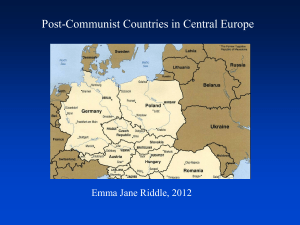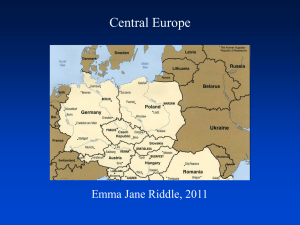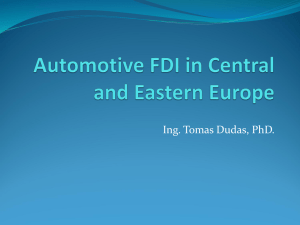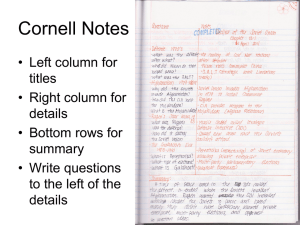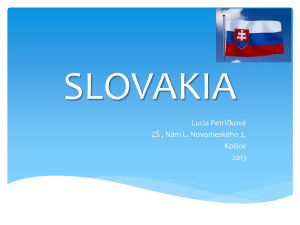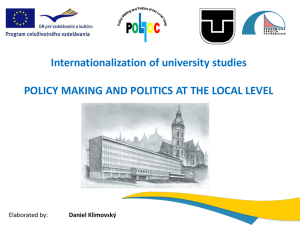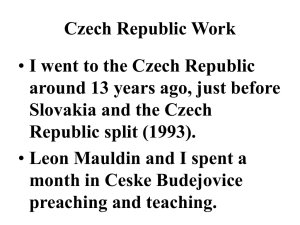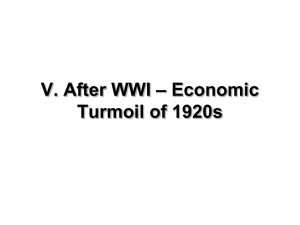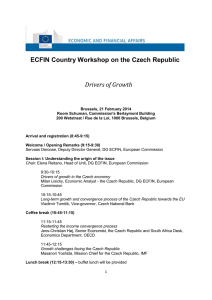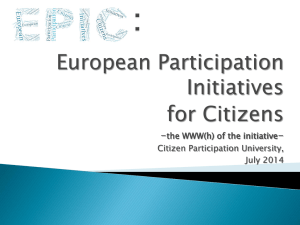Snímek 1
advertisement
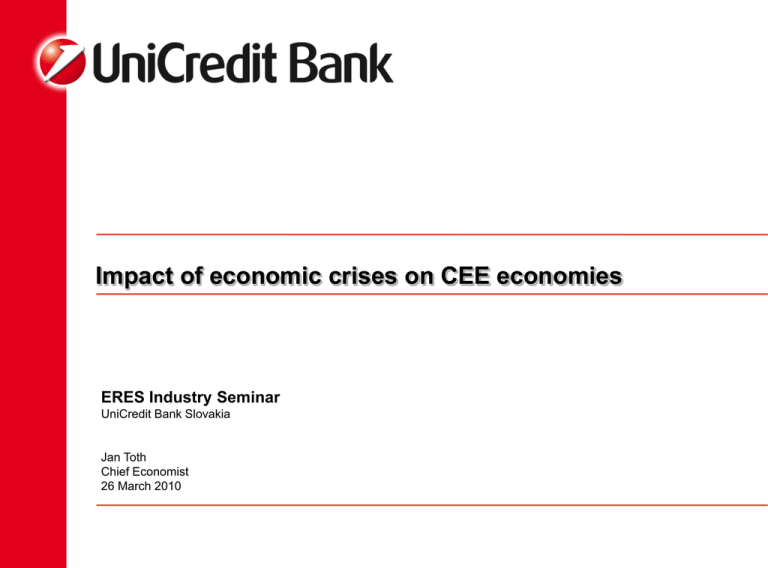
Impact of economic crises on CEE economies ERES Industry Seminar UniCredit Bank Slovakia Jan Toth Chief Economist 26 March 2010 Global pictures Key Western European markets Price pressures vs. economic cycle Interest rates Soft indicators 2 Openness of the economy (export+import as % of GDP) Slovakia is extremely small open economy, depended on foreign demand 180% 161% 160% 168% 149% 140% 113% % z HDP 120% 100% 83% 88% 80% 60% 40% 55% 58% FR IT 31% 20% 0% US 3 Zdroj: Eurostat (2008) PL DE AT CZ HU SK 4 Q1 06 Q2 06 Q3 06 Q4 06 Q1 07 Q2 07 Q3 07 Q4 07 Q1 08 Q2 08 Q3 08 Q4 08 Q1 09 Q2 09 Q3 09 Q4 09 Q1 10f Q2 10f Q3 10f Q4 10f Q1 11f Q2 11f Q3 11f Q4 11f Economic growth in European biggest economies Germany in deepest recession (share of industry is the biggest) DE FR IT 6 4 2 0 -2 -4 -6 -8 Cash for clunkers – mostly gone by 1H10 5 (Core) inflationary pressures should remain low Eurozone Core CPI vs. Output Gap 6 Less important energy and food prices could increase. Source: Capital Economics Broader Money does not grow despite printing press 7 Source: Capital Economics Short-term interest rates, forecasts ECB - Later to cut rates, later to increase rates 5 4 3 2 1 Month 3 Month 6 Month 1 Key Rate 8 Source: UniCredit I-12 VII-11 I-11 VII-10 I-10 VII-09 I-09 VII-08 I-08 VII-07 I-07 VII-06 I-06 VII-05 I-05 VII-04 I-04 VII-03 I-03 VII-02 I-02 VII-01 I-01 VII-00 I-00 VII-99 I-99 0 Long-term interest rates in eurozone German 10-yr government bonds, yield curve should become less steep 8,7 7,7 6,7 5,7 4,7 3,7 2,7 10Y BUnds 1,7 2Y Bunds Source: UniCredit 9 I-12 I-11 I-10 I-09 I-08 I-07 I-06 I-05 I-04 I-03 I-02 I-01 I-00 I-99 I-98 I-97 I-96 I-95 I-94 I-93 I-92 I-91 I-90 0,7 “Soft” indicators point to stronger 2Q10 Eurozone (esp. Germany) enjoys industrial production revival 10 Source: Capital Economics VI.08 VII.08 VIII.08 IX.08 X.08 XI.08 XII.08 I.09 II.09 III.09 IV.09 V.09 VI.09 VII.09 VIII.09 IX.09 X.09 XI.09 XII.09 I.10 II.10 III.10 IV.10 V.10 VI.10 VII.10 VIII.10 IX.10 Slovak example - zoomed on recent data 11 15% IFO Exp. (normalized) 10% ZEW (normalized) 5% Slovak Manufacturing (ex-auto) 0% -5% -10% -15% -20% -25% “Soft” indicators point to still low levels of stocks compared to orders The ratio signals that “recovery” is not over yet 63 1,4 60 1,3 57 1,2 54 1,1 51 1,0 48 0,9 45 0,8 42 39 36 33 VI.97 12 Source: UniCredit 0,7 Mfg PMI - LS 0,6 New Orders-to-Stock Ratio - RS 0,5 XII.99 VI.02 XII.04 VI.07 XII.09 CEE economies Living standards Growth forecasts and investments Euro adoption had negative short-term impact Polish and Hungarian labour force cheap vis-à-vis neighbours Recession was the deepest in Slovakia, but recovery swift Large fiscal deficits could push tax rates higher after elections 13 Living standards in historical perspective ( EU15=100% ) Living standards catch-up stalled during global crisis 80 70 60 50 40 30 Bulgaria Hungary Poland Romania Slovakia 2011F 2010F 2009e 2008 2007 2006 2005 2004 2003 2002 2001 2000 1999 1998 1997 Czech Republic Source: Eurostat. February 2010. 14 1996 1995 1994 1993 1992 1991 20 CEE growth Poland was best off in 2009 due to smaller export share 11 10 9 8 7 6 5 4 3 2 1 0 -1 -2 -3 -4 -5 -6 -7 -8 10,6 8,5 6,7 4,8 5,0 1,6 3,8 3,1 2,42,72,7 2,3 -0,3 Czech Republic Hungary Poland Slovak Republic -4,7 2003 15 6,2 2004 2005 2006 2007 2008 2009 2010f 2011f CE4 growth and investments – Czech R & Slovakia Czech Republic - Y-o-Y 15,0 6,8 6,1 GDP 2,5 1,6 Investments 10,0 3,5 3,5 5,0 2,4 3,1 3,3 0,0 -5,0 -4,3 -10,0 1,15 1,10 1,05 1,00 0,95 0,90 0,85 0,80 6,0 3,0 0,0 10,6 16 0,95 0,90 0,85 GDP Investments 0,80 Slovakia - 2008=1 GDP 15,0 10,0 Investments 6,2 4,3 3,1 3,8 2,2 5,0 5,0 4,0 0,0 -5,0 -4,7 20 06 20 07 20 08 20 09 20 10 F 20 11 F 20 12 F 20 13 F 20 14 F 20 15 F -3,0 -6,0 8,5 1,00 -10,0 -15,0 1,20 1,15 1,10 1,05 1,00 0,95 0,90 0,85 0,80 GDP Investments 20 06 20 07 20 08 20 09 20 10 F 20 11 F 20 12 F 20 13 F 20 14 F 20 15 F Slovakia - Y-o-Y 12,0 9,0 1,05 20 06 20 07 20 08 20 09 20 10 F 20 11 F 20 12 F 20 13 F 20 14 F 20 15 F 20 06 20 07 20 08 20 09 20 10 F 20 11 F 20 12 F 20 13 F 20 14 F 20 15 F 8,0 6,0 4,0 2,0 0,0 -2,0 -4,0 -6,0 Czech Republic - 2008=1 1,20 1,15 1,10 1,05 1,00 0,95 0,90 0,85 0,80 CE4 growth and investments – Poland & Hungary Poland - Y-o-Y 6,2 GDP 6,8 4,9 Investments 4,2 2,6 4,0 3,5 2,7 1,7 20,0 1,30 1,20 15,0 1,20 1,10 10,0 1,10 1,00 1,00 0,90 5,0 3,4 0,0 -5,0 GDP 0,90 Investments 0,80 0,80 0,70 20 06 20 07 20 08 20 09 20 10 F 20 11 F 20 12 F 20 13 F 20 14 F 20 15 F 20 06 20 07 20 08 20 09 20 10 F 20 11 F 20 12 F 20 13 F 20 14 F 20 15 F 8,0 7,0 6,0 5,0 4,0 3,0 2,0 1,0 Poland - 2008=1 Hungary - Y-o-Y Hungary - 2008=1 1,20 0,9 0,7 -0,3 17 15,0 3,510,0 5,0 0,0 -6,5 1,10 1,05 GDP Investments 1,00 0,95 -5,0 -10,0 0,90 20 06 20 07 20 08 20 09 20 10 F 20 11 F 20 12 F 20 13 F 20 14 F 20 15 F 4,1 Investments 4,0 3,5 2,7 3,4 20 06 20 07 20 08 20 09 20 10 F 20 11 F 20 12 F 20 13 F 20 14 F 20 15 F 6,0 4,0 2,0 0,0 -2,0 -4,0 -6,0 -8,0 GDP 1,15 1,10 1,05 1,00 0,95 0,90 Interest rate premium ( vs. German government, 10 yrs, in % ) Slovakia benefits due to euro adoption, but Czech R is close second 5,0 4,9 4,5 4,3 4,0 3,5 today (10Y) 3,3 before crisis (10Y) 3,0 today (1Y) 2,4 2,5 2,0 1,5 1,0 1,1 0,9 1,0 0,5 0,3 0,0 Slovakia 18 Czech R Poland Hungary Hourly (total) labour costs in manufacturing (EUR) Slovakia got sharply more expensive in relative terms 1996 2008 Mar-10 % of CE4 avg % of EU15 avg Czech Republic Hungary Poland Slovakia 2.6 2.7 2.7 2.3 8,6 7,0 7,0 7,3 8,9 6,8 6,7 7,5 119,1 90,8 89,2 100,9 29,9 22,8 22,4 25,3 CE4 average Old EU15 avg. 2.6 19.4 7,5 29,4 7,5 29,7 100,0 28,9 25,1 100,0 Germany 24.8 32,7 32,6 33,1 109,8 Note: Labour costs include all costs borne by an employer. CE exports mainly consist of industrial goods. The average annual increase for CE costs was 8.5% in 1996-2006 period while it was 3% for EU15 and 1.7% for Germany. Source: 1996 -2008 is EUROSTAT data, the rest is an estimate. The latest data based on present exchange rates. 19 % premium/discount to CE4 average Slovakia cannot react to slowdown via exchange rate, becomes more expensive 25% % deviation from CE average 20% 15% 10% 6% 5% 1% 0% -2% -5% -10% -15% -5% -7% -12% -10% -10% -14% -14% -16% -20% -22% -22% -25% 96 97 98 99 00 01 Czech R 20 -12% -14% 02 03 Hungary 04 Poland 05 06 Slovakia 07 08 09 III.10 Industry (manufacturing, s.a., July 2008 = 100) Slovakia was hit the hardest, but stronger recovery 1,05 EU-15 Hungary Czech Republic Poland Germany Slovakia 1,02 1,00 0,95 0,94 0,93 0,90 0,89 0,88 0,85 0,85 0,80 21 Source: Eurostat, UniCredit calculation 0 I.1 XI .0 9 XI I.0 9 X. 09 09 IX . VI .0 9 VI I.0 9 VI II. 09 V. 09 09 IV . 09 III . 9 II. 0 9 I.0 XI .0 8 XI I.0 8 X. 08 IX . 08 0,75 Construction (sept 2008 = 100, seas. adjusted, 3M MA) Slovakia was the most hit, Hungary 2nd worst 1,10 1,05 1,04 1,00 0,95 0,94 0,90 0,89 0,85 0,80 Czech Republic Hungary Poland 0,77 Slovakia 22 Source: Eurostat, UniCredit calculation 0 I.1 XI .0 9 XI I.0 9 X. 09 09 IX . VI .0 9 VI I.0 9 VI II. 09 V. 09 09 IV . 09 III . 9 II. 0 9 I.0 XI .0 8 XI I.0 8 X. 08 IX . 08 0,75 Real estate construction (sept 2008 = 100, seas. adjusted, 3M MA) Slovakia and Hungary was the most hit 1,00 0,96 0,95 0,90 0,88 0,85 0,80 0,78 Czech Republic Hungary Poland Slovakia 0,75 23 Source: Eurostat, UniCredit calculation 0 I.1 XI .0 9 XI I.0 9 X. 09 09 IX . VI .0 9 VI I.0 9 VI II. 09 V. 09 09 IV . 09 III . 9 II. 0 9 I.0 XI .0 8 XI I.0 8 X. 08 IX . 08 0,75 Construction - survey on current orders (s.a.) Orders still very low 10 Czech Republic Hungary Poland Slovakia 0 -10 -20 -30 -40 -50 -60 -70 24 Source: Eurostat I.10 X.09 VII.09 IV.09 I.09 X.08 VII.08 IV.08 I.08 X.07 VII.07 IV.07 I.07 X.06 VII.06 IV.06 I.06 -80 Retail sales (w/o cars, 2008 average = 100) Slovakia was hit the hardest, 10% below average 2008 level 1,05 1,03 1,01 0,99 0,97 0,95 EU15 CZ DE HU PL SK 0,93 0,91 0,89 Source: Eurostat, UniCredit calculation 25 I.10 XII.09 XI.09 X.09 IX.09 VIII.09 VII.09 VI.09 V.09 IV.09 III.09 II.09 I.09 XII.08 XI.08 X.08 IX.08 0,87 GDP output (pre-crisis level 100%, quarterly development, s.a.) Slovakia was the most hit, but strongly rebounds 1,04 1,03 1,02 1,00 0,98 0,97 0,96 0,96 0,95 0,94 0,92 Czech Republic Hungary Poland Slovakia 0,90 2008Q04 Source: Eurostat 26 2009Q01 2009Q02 2009Q03 2009Q04 Unemployment (an increase since the start of the crisis, s.a.) Slovakia was the most hit 5,0 4,9 4,5 Czech Republic Hungary Poland Slovakia 4,0 3,9 3,5 3,3 3,0 2,5 2,1 2,0 1,5 1,0 0,5 Source: Eurostat 27 0 I.1 9 XI I.0 XI .0 9 X. 09 09 IX . 9 VI II. 09 VI I.0 VI .0 9 V. 09 09 IV . 09 III . 9 II. 0 9 I.0 XI .0 8 XI I.0 8 X. 08 IX . 08 0,0 EUR race, no quick euro candidate in CE3 Slovak neighbors will continue to have floating exchange rate Pre-euro ERMII entry Euro adoption date Slovakia 2H05-2008 2009 Estonia 2004-2010 2011 2004-2013 2004-2013 Currency board to 2013 2014 2014 2014 Hungary 2012-2014 2015 Poland 2013-2015 2016 Czech Republic 2015-2017 2018 Latvia Lithuania Bulgaria 28 Source: UniCredit, Barclays On-going hope for CEE Faced with a short-term deflationary/disinflationary environment, global corporations will lack pricing power and will have to work aggressively on costs to support the bottom line. This will continue to have important implications for CEE markets that have benefited from off-shoring. In terms of the geographic location of production such pressures could end up producing more not less off-shoring Potential threat: due to high fiscal deficit numbers, taxes could be increased in the future 29 Contacts 30 Jaroslav Habo Tel: +421 2 4950 4319 E-mail: jaroslav.habo@unicreditgroup.sk Large and multinationals František Doležal Tel: +421 2 4950 2272 E-mail: frantisek.dolezal@unicreditgroup.sk Mid segment Marian Burian Tel: +421 2 4950 3207 E-mail: marian.burian@unicreditgroup.sk SME clients Margita Slaninková Tel: +421 2 4950 2271 E-mail: greta.slaninkova@unicreditgroup.sk Real Estate Financing Ján Tóth Tel: +421 2 4950 2267 E-mail: jan.toth@unicreditgroup.sk Research David Derenik Tel: +421 2 4950 2368 E-mail: david.derenik@unicreditgroup.sk Research – Real Estate
